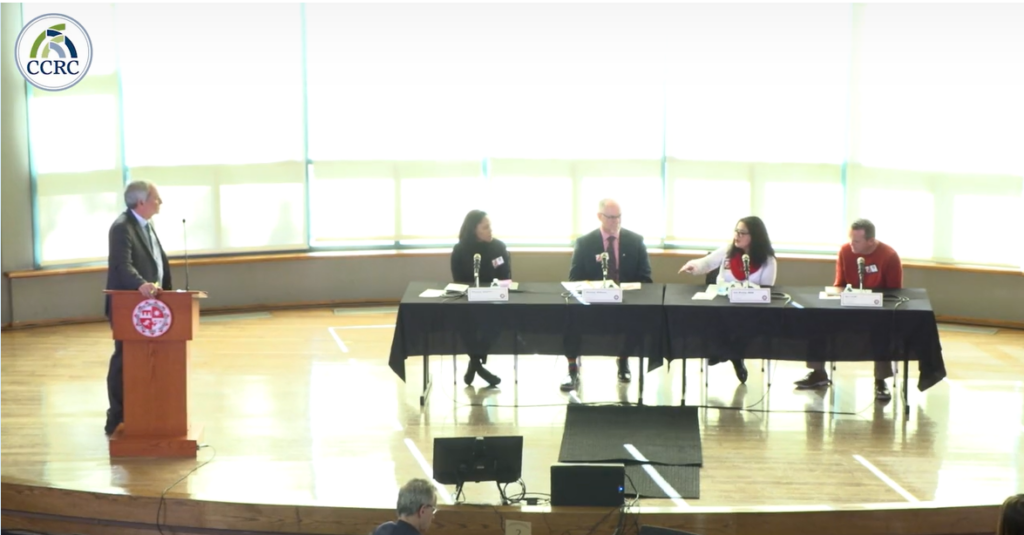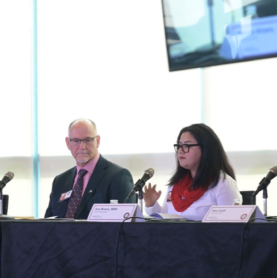The demographic of Los Angeles County families is changing and with that comes a need for individualized services and resources. This was one of the topics of discussion at CCRC’s 2024 Policy Forum, where a panel of experts weighed in on the hurdles families face to accessing necessary supports. Watch the full discussion here.
The event held at California State University, Northridge was sponsored by First 5 LA and moderated by CCRC President and CEO Dr. Michael Olenick. The theme was Leave No Family Behind and panelists included Michael Williams, Shimica Gaskins, Ken Craft, Eva Rivera and keynote speaker Manuel Pastor, Ph.D.

Changing Demographics
In his opening remarks, Pastor discussed the changing demographic of Los Angeles County. In 1990, about a third of all immigrants in the U.S. lived in CA but it’s now about 22.5 percent. He explained that many immigrant families in California are moving away, due to cost of living. View his presentation here.
“Immigration has left its marks on Los Angeles County,” Pastor said. “More than 70 percent of the undocumented population has been here more than a decade. As a result, what do they do? Find love, have families, settle in, become a permanent part of our infrastructure. That’s one of the reasons we’ve taken to not talking about undocumented immigrants and talking about undocumented Californians.” Pastor added that 20 percent of all children in LA County have at least one undocumented parent, which is why he argued that getting insurance and government resources to these families is so important.
And in terms of racial inequality, Pastor shared data that demonstrated the average incomes for families of different races with children under age 5. White families earned about $145,200, while Black families earned $62,100 and Latino families earned $64,900 on average.
“Really coming away with this understanding of how demographics are changing and therefore what that means for as we think about policy. Not just thinking about the past, which I think is important, not just thinking about the present which we tend to do, but also considering the future and I think that was a new lens to take on our work and how we think about it, being really mindful about not just who we’re serving now but who we may be serving in the future and what that landscape may look like,” said Rachel Klein, who works for the City of Los Angeles’ Child Care Policy and Equity Unity.

Access to Resources
Panelists discussed the need for streamlined access to resources, which are often sometimes difficult for families to locate and utilize.
“Over the holiday break, a young baby only one year old passed away near the LAX airport, at a bus stop. Her family was houseless, her name was Yayra Rutherford,” said Gaskins. “What we’re trying to do for those who are already on the street and also trying to make sure families don’t fall off the guardrails comes back to things like guaranteed income and cash rewards. … So, while we’re continuing to do a lot of work at the state level to push these issues and work at the county level to deal with folks who don’t have the help and support they need and are currently on the streets, we know the best solution is to keep families housed today.”
“Reduce the barriers that exist for families. We know California looks good on paper, but implementation is lacking,” said Manuel Fierro, Catalyst CA Associate Director. “Also thinking about wholistic needs and how do we bust those silos that exist so housing isn’t positioned against child care against food security, all these things are so important. How do we start with family in mind instead of systems in mind.”
“Understanding economics for families and impact on youth for life, so really going in and looking at tangible way we can bring resources to families,” said Andrea Rosenthal, the district director for CA Assm. Pilar Schiavo. “It’s not enough to have resources available, if there’s isn’t that one stop shop where families know they can go to get resource, it can be community driven in addition to evidence based.”
Housing Security
In discussing the issue of housing insecurity, Hope the Mission CEO Ken Craft said poignantly “the streets cannot be the waiting room for affordable housing.” He described the shortage of child care options for mothers experiencing homelessness and said that was a major hinderance to women finding employment.
“Housing insecurity or homelessness, bullying, discrimination, having escaped from a war-torn country, a relative that has been incarcerated – these are the things we need to be looking at, particularly when we’re interacting with young children, when we see something that could be classified as oppositional defiance disorder or behavioral issues, always going back to what is happening with this child, what has happened to this child, is this child safe?” explains Emily Williams, UUCAN CEO.
Moving Forward
CCRC VP and Chief Strategy Officer Donna Sneeringer said in her follow-up discussions with attendees, many of whom work in child advocacy or child care, the sentiment was one of optimism and interest in finding solutions.
“I think people are hopeful, there’s this great understanding of this willingness to partner and understanding that we do have resources we could use better and we could do things differently with the dollars we have going into a difficult budget year. It’s always easy to say what we need is more money but sometimes we need better regulations and better laws, and how do we use this year to really frame up better solutions with our existing programs,” said Sneeringer.




